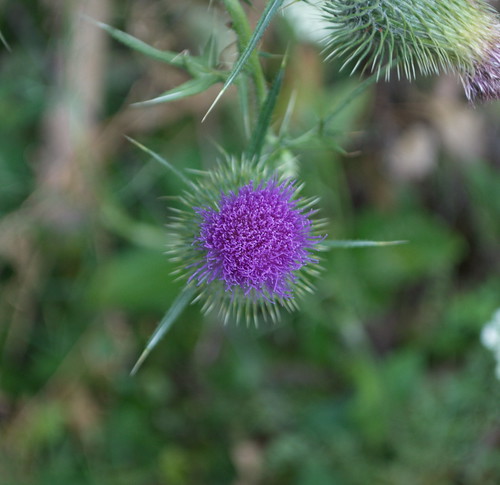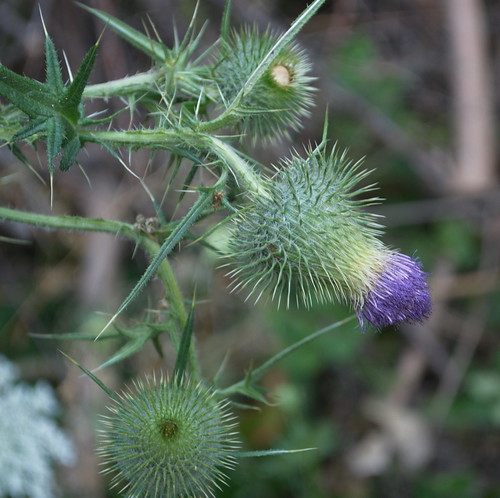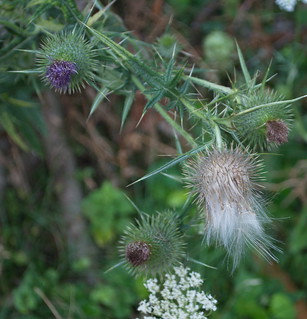It's a lovely flower. The purple of the bud is quite distinctive. It is native to the Mediterranean and north to Scandinavia working east to Asia. It's impossible to miss as it's about 3 feet tall with large branching leaves which are covered with intimidating looking spikes. It blooms pretty much anywhere although it prefers disturbed soil. It's
considered a biennial although much depends upon when its seeds sprout. These seeds are spread usually by the wind although humans and animals will also spread them. Finches love the seeds and will land on the plant to pick the seed heads clean. Studies show seeds can lay dormant for 5 years but it's not considered unusual for seeds to germinate up to 20 years. Clearly, this is one tough plant.
It's called the Cotton Thistle or, more notably, the Scottish Thistle, the national emblem of Scotland. I have one growing in my yard.
I didn't know that's what it was until it bloomed. It's off a corner of my neighbor's fence and it was out of sight until the purple blooms showed up.
I remember helping dad weed these things on the farm. They are tenacious and I thought they had it in for me. You must wear heavy, heavy gloves when handling them. Dad would cut the plant down and I'd be responsible for picking it up and tossing it onto a pile we were making. He'd then take the pile to the burn barrel and torch them. Cattle will not eat these unlike other thistles and a row of them is almost impregnable, due to the thorns on the leaves and stems.
I noticed today that the first blooming flower has gone to seed. I should probably snip off this seed head and all the rest of the flowers, put them in a paper bag and dispose of it. This really isn't something I want in my yard regardless of the connection it has to my heritage. I should also probably spray the remaining plant with Round-Up to make sure it dies and doesn't flower any more this year. Given that there is one plant here, that probably means there will be others sprouting in this location so due diligence will be needed.
And yet, I'm a bit torn because I used to have a goldfinch family in the yard and this is just the kind of plant they love. Given all the flowers on it, I could feed a couple of families or more than just goldfinches, (wince) but it's a noxious weed. Really.
For a number of years, I made these pins for the women in my clan. I found the thistle pattern in one of my cross-stitch books and it was clear to me it would make an excellent pin. I haven't made any in a few years as the backing was quite costly and I haven't been able to find anything cheaper.
How did the thistle come to represent Scotland and the Scottish people? No one knows. It's the stuff of a good legend. The story goes that a group of Scotsmen fell asleep while defending the country from attacks by Norsemen. The Norsemen came ashore at night, preparing to rout the Scots and claim the land. One of the Norsemen happened to step on a thistle in his bare feet, as boots were a luxury for the fighting man back then, and screamed in agony. This awoke the Scots and they routed the Norsemen and sent them home.
Whatever the real story, the thistle growing in my yard is synonymous with Scotland. Given the anguish I know it causes in a yard, can I summon up the will to remove it before it becomes a pest?
Beverage: Darjeeling tea
Deb




No comments:
Post a Comment